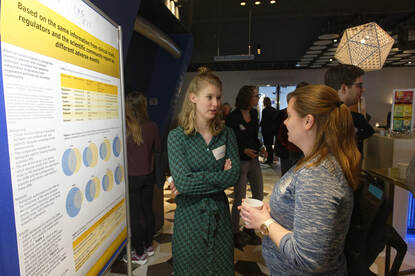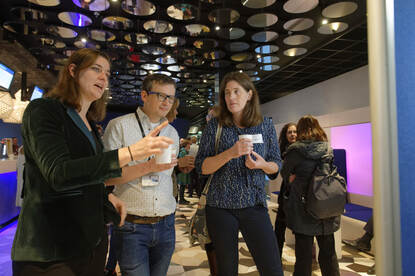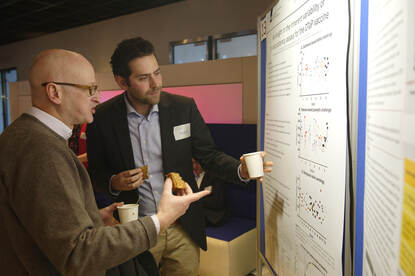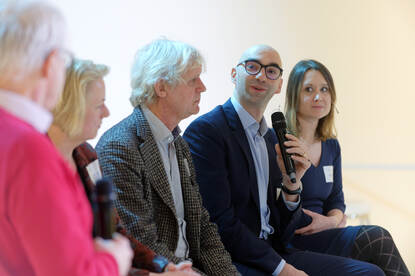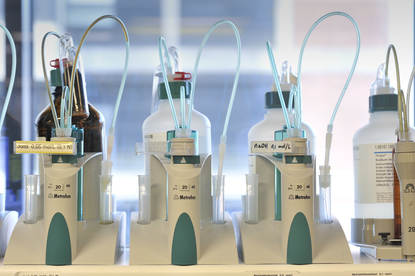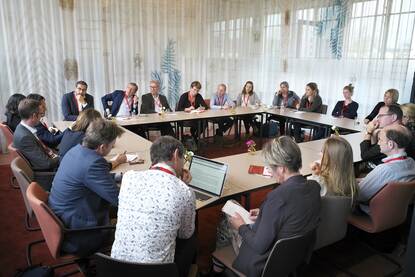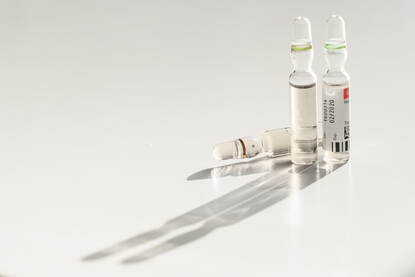Replacement, reduction and refinement of animal studies: a common goal in the regulatory testing of medicinal products for humans
Animal testing is, unfortunately, still required for the development of new and safe medicines. But a lot of research is being done on replacing, reducing and refining these animal tests; by the pharmaceutical industry, numerous academic groups and different regulatory authorities, in various partnerships and at different levels. Results from this research have already been implemented, more and more knowledge is being shared and new insights are obtained on a daily basis.
During the MEB Science Day of 13 February 2020, results and developments in the research on replacing, reducing and refining the use of animals in research, the 3Rs, were presented from different perspectives. With over 150 attendees from the pharmaceutical industry, academic groups, regulatory authorities and government departments, several speakers and poster-presentations and a lively panel discussion, the MEB looks back on a successful and inspiring meeting.
Is re-evaluation the 4th R?
There are international guidelines for drug research, the International Conference on Harmonization of Technical Requirements for Registration of Pharmaceuticals for Human Use (ICH). With the introduction of these guidelines, the technical requirements for animal testing were harmonized internationally, which allowed for a significant reduction in required animal experiments. However, a critical re-evaluation of these guidelines, based on new scientific insights, can potentially result in a further reduction.
“Since the thalidomide tragedy, reproductive toxicity testing in two species is required,” says dr. Peter van Meer, non-clinical assessor at the Medicines Evaluation Board (MEB). “However, research of dr. Peter Theunissen (non-clinical assessor at the MEB) and others on the comparison of rat and rabbit reproductive toxicity data showed that these animal models generate comparable data. Therefore, the recently revised ICH guidelines for reproductive toxicity testing allow a limited dataset generated in only one species supplemented with an in vitro assay up to phase III clinical trials, allowing a significant reduction in the required animal experiments.”
Dr. Fiona Sewell, programme manager at the National Centre for the Replacement, Refinement and Reduction of Animals in Research (NC3Rs), presents another example of a guideline revision resulting in fewer animal studies. In collaboration with partners from the pharmaceutical industry, the relevance of the single dose acute toxicity tests were re-evaluated. Analysing acute toxicity data of 70 compounds provided by 17 companies from the US and EU, led to the insight that neither companies nor regulatory agencies considered the studies to be informative or needed and thus led to the removal of the requirement for single dose acute toxicity tests in the international guidelines from 2009.
(Text continues below video)
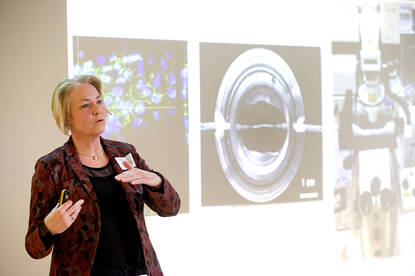
Monoclonal antibodies, biosimilars and ATMP’s
ICH guidelines evolved, based predominantly on testing requirements for small-molecule drugs. But with novel treatment modalities such as biotechnology therapeutics, gene therapy and cell therapy, the predictive value of the animal studies are increasingly under scrutiny. Van Meer: “This has led to a risk based approach for biosimilars, the generic ‘copies’ of biotechnology therapies, in the EU: no in vivo studies unless needed. And also for the ATMP’s, we are aiming at the principle: ‘no, unless…’.”
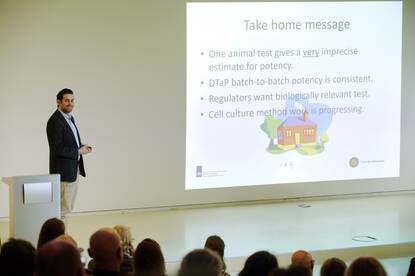
Black box
Humans are animals, but are animals human enough?, is a question Prof. Roos Masereeuw, professor of Experimental Pharmacology at Utrecht University, poses. Masereeuw: “We’ve studied renal clearance data for 20 different active pharmaceutical substances in several animal models and their predictivity for humans. The results showed good predictive power for several animal models. Except for the rat. But the rat is the most used in vivo model.” Animal models are sort of a black box and their predictive value can be challenged. Therefore, 3R-research is imperative, not only on moral and ethical grounds, but also to improve the predictive value of the tests. Masereeuw: “Using materials of human origin in an in vitro environment may improve the predictiveness, but we must keep in mind that no model is or ever will be perfect.”
(Text continues below video quotes)
Images of cell culture plates and Petri dishes probably spring to mind when thinking about alternatives for animal experiments. However, developing an in vitro assay is not that easy, as Coen Stalpers (PhD student of Utrecht University and MEB, and quality assessor at the MEB), clarifies in his presentation. But he also demonstrates the necessity of robust alternative assays to test the potency of vaccines: “In vivo potency tests are required for the testing of vaccine batches. But the results of these in vivo potency assays are inherently variable”. The development of an in vitro assay could solve this variability problem.
Prof. Coenraad Hendriksen, senior scientist at Intravacc and emeritus professor at Utrecht University, drives home the necessity for in vitro assays even further, since for vaccine production the potency of every batch must be determined. However, despite the challenges that are inherent in 3R-research, much progress has already been made in this field. For example, lethal challenge tests in the batch potency testing of diphtheria and tetanus toxoid vaccines have been replaced by serological assays and the specific toxicity test for diphtheria vaccines has been replaced by an in vitro assay.
(Text continues below video quotes)
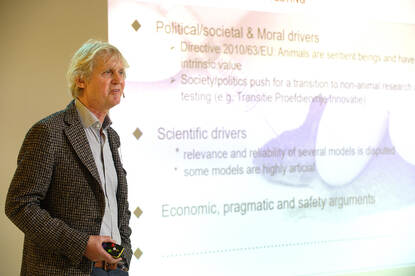
Public-private collaboration
The importance of collaboration between the pharmaceutical industry, numerous academic groups and different regulatory authorities is stressed by several speakers. Coenraad Hendriksen referred to the Catch22 situation that: “Manufacturers may be reluctant to invest in an alternative test without assurance of regulatory acceptance, while regulators may be reluctant to assure acceptance in the absence of data.” The VAC2VAC-project is a good example, where 15 public partners and 7 vaccine producers are working together to establish in vitro batch testing of vaccines. But also the results presented by Fiona Sewell were largely established because of data sharing between pharmaceutical companies and the UK NC3Rs, an independent scientific organisation. This shift towards more collaboration and early regulatory dialogue between stakeholders, especially in the last decade, was also pointed out by Peter van Meer.
After a lively and interactive panel discussion, Hugo Hurts, executive director at the MEB, also stressed the importance of collaboration on 3R-research in the regulatory testing of medicinal products for humans. He pointed towards the active role of the MEB in this field, but also towards the importance of sharing the available knowledge. “To make a real impact, we must share our knowledge on a global scale. Therefore, this topic is on the agenda of the next meeting of the International Coalition of Medicines Regulatory Authorities (ICMRA), where we will present the progress that has been made in Europe.”
MEB Science Day 2020 - Presentations
- Realising an optimal safety and efficacy assessment with a minimum of animal studies: MEB experience with 3Rs
dr. Peter van Meer, non-clinical assessor Pharmacology, Toxicology and Pharmacokinetics MEB
- Moving away from animal use: the IMI VAC2VAC project. Opportunities & challenges
dr. Coenraad Hendriksen, senior scientist Intravacc and emeritus professor Utrecht University
- Potency tests in animals are not precise. The inherent variability of in vivo potency tests for vaccines
Coen Stalpers, PhD candidate, Utrecht University, quality assessor MEB
- Applying the 3Rs in Toxicology and Regulatory Sciences
dr. Fiona Sewell, Programme Manager Toxicology and regulatory sciences, human health effects NC3R
- Advanced in vitro models for drug development: the complexity of simplicity
prof. Roos Masereeuw, professor of Experimental Pharmacology Utrecht University
